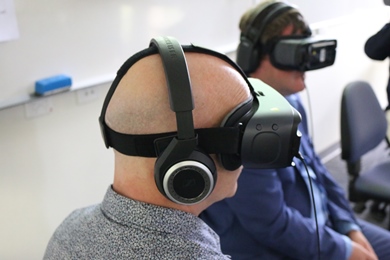11 December 2017
 Journalism has emerged as one of the 21st century’s most rapidly “disrupted” industries as the rise of social media has undermined the effectiveness of traditional journalism. So how do you teach journalism in this new context so that it is meaningful and relevant to new generations of journalists?
Journalism has emerged as one of the 21st century’s most rapidly “disrupted” industries as the rise of social media has undermined the effectiveness of traditional journalism. So how do you teach journalism in this new context so that it is meaningful and relevant to new generations of journalists?
UniSA is pioneering a new virtual reality journalism app that delivers a learning environment where students can develop both their digital production and technological understanding of new media environments, while also honing their traditional journalism skills.
With the only dedicated journalism program in the state, UniSA recognises there is huge need for students to learn about new ways of capturing and reporting news in a digitally enriched environment.
The new app, named Immerse, developed in a collaboration between UniSA’s School of Communication, International Studies and Languages, and its School of Information Technology and Mathematical Sciences, allows journalism students to create and distribute virtual reality (VR) news stories.
The pilot study saw 10 Bachelor of Journalism and Media/Arts students in their final year project or internship course, produce VR stories to demonstrate their grasp of the new emerging technologies.
Project leader and lecturer in journalism, Dr Ben Stubbs says the app will ensure UniSA journalism graduates are better equipped to succeed in a changing journalism environment.
“Students who completed this course positively met the related challenges of learning how to use an emerging technology, while developing meaningful social stories.” Dr Stubbs says.
“At the same time as learning how to use a new and changing technology, students had to work out how to visually and aurally tell their stories.
“Students shot material on new 360 degree video cameras within ‘Immerse’ allowing them to construct the VR experience using hotspots and story interactivity, a little like a ‘choose your own adventure’ story,” Dr Stubbs says.
The project is unique because the newly developed app allows students to create their stories without needing complex coding knowledge.
With a wave of new VR hardware and software predicted to be available by 2020, the emergence of VR as an affordable, accessible and popular form of storytelling is something Dr Stubbs says all journalists will need to understand and be able to use.
“After the success of this pilot program, UniSA will now offer the stand alone course - Virtual Reality Storytelling in 2018 as a component of the journalism degree structure,” he says.
The technology designers also hope to adapt the Immerse app so that it can be used in other courses such as visual art, design and health sciences, where a VR narrative could be applied.
A powerful example of VR journalism was produced by the United Nations and filmmaker Chris Milk in 2015. The short video, Clouds over Sidra, allows viewers to experience the daily life inside a Syrian refugee camp.
Students in the UniSA pilot program produced stories about South Australia’s homeless, an animal welfare shelter and the same sex marriage debate, among others. View an example here.
Media contact: Georgia Minarelli mobile: +61 413 314 726 email: Georgia.Minarelli@unisa.edu.au
Dr Ben Stubbs 0406 159 353, Ben.Stubbs@unisa.edu.au




